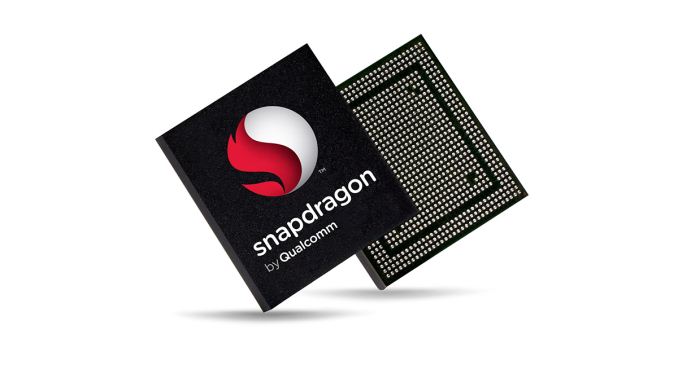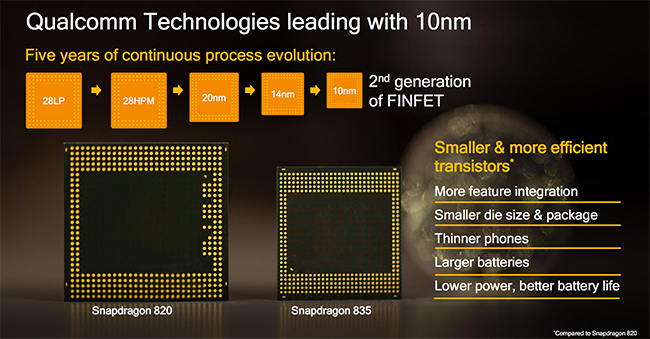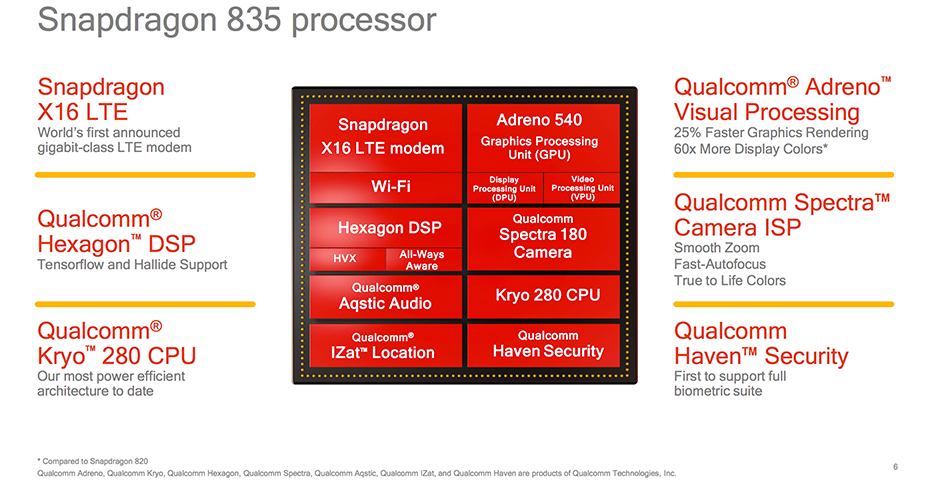Qualcomm Details Snapdragon 835: Kryo 280 CPU, Adreno 540 GPU, X16 LTE
by Matt Humrick on January 3, 2017 5:00 PM EST- Posted in
- Smartphones
- Snapdragon
- Qualcomm
- Adreno
- Mobile
- Snapdragon 835
- Kryo

Qualcomm previously revealed the name of its new high-end SoC, but today at CES 2017 it discussed the Snapdragon 835 in greater detail. Replacing the Snapdragon 820/821 as the pinnacle processor in its lineup, the 835 is the first commercial SoC to use Samsung’s 10nm "10LPE" FinFET manufacturing node. Qualcomm did not disclose die size, but it said the overall package size is 35% smaller than the Snapdragon 820 and contains more than 3 billion transistors. Samsung says its third-generation FinFET node “allows up to a 30% increase in area efficiency with 27% higher performance or up to 40% lower power consumption” relative to its first-generation 14nm 14LPE node at the same frequency, so Snapdragon 835’s process advantage over the 820, which uses Samsung’s second-generation 14LPP node, will be a bit less.
In addition to smartphones and tablets, Qualcomm sees the 835 powering IP cameras, VR and AR head-mounted displays (it has a reference HMD design available for partners and says several products are currently in development), and even new ultra-portable cellular PC devices with full Windows 10 support. This includes both Universal Windows Platform (UWP) apps, which run natively, and legacy x86 (32-bit) Win32 apps, which use software emulation. These new PC devices should also support any peripherals already supported by Windows 10 and eSIM support for cellular connectivity.
Qualcomm finds itself in a much different position today compared to one year ago when it launched the Snapdragon 820. Back then, it was on the hot seat after its previous flagship products, the Snapdragon 808 and 810, failed to meet expectations. Qualcomm’s implementation of ARM’s Cortex-A57 CPU core and TSMC’s last 20nm planar process were not a good combination, resulting in a generation of flagship phones that struggled to meet or exceed the performance of older models and exhibited higher than normal skin temperatures. The success of Snapdragon 820 would be crucial to regaining its partner’s trust and restoring its image with consumers.
The 820 was pivotal for another reason too: It introduced Qualcomm’s first custom 64-bit CPU core, Kryo. Creating a custom CPU (or GPU/DSP/ISP) is one way for SoC vendors to differentiate their products and establish themselves as innovators. Snapdragon 810’s use of stock ARM cores could be construed as a step backwards then after previous Snapdragon SoCs used Qualcomm’s custom Krait CPUs. Apple’s prior introduction of a custom 64-bit CPU, which caught everyone by surprise, only added fuel to the fire.
The Snapdragon 820 would go on to become a commercial success with many design wins. It powers the majority of flagship phones released over the past year, and while Kryo trails ARM’s A72 and Samsung’s M1 CPUs in IPC, it performs well enough to deliver a solid user experience.
With today’s launch of Snapdragon 835, Qualcomm looks to build on the 820’s success and its vision for the future: heterogeneous computing. By combining the unique abilities of each processor type—CPU, GPU, and DSP—Qualcomm hopes to bring new features and experiences, such as VR and machine learning, to mobile devices.
The 820 introduced several key features that form the foundation of this vision, which is why it’s so important to our discussion of the 835. Its Hexagon 680 DSP added single instruction, multiple data (SIMD) Hexagon Vector Extensions (HVX) specifically aimed at accelerating the aforementioned VR and machine learning workloads, along with more efficient processing of photography and computer vision tasks. The Adreno 530 GPU’s compute capabilities received a boost too, and the GPU and CPU gained the ability to snoop into the other’s cache using shared 64-bit virtual memory addressing, enabling better sharing of data. Qualcomm also introduced its Symphony System Manager alongside the 820 to provide task scheduling and power management for the various processor cores.
The Snapdragon 835 is more evolutionary than revolutionary by comparison. Every block within the new SoC receives an update, however, enabling new features and claims of higher performance and better battery life. With the backstory complete, it’s time to discuss these changes in more detail, starting with the biggest change of all: the CPU.













58 Comments
View All Comments
colinisation - Saturday, January 7, 2017 - link
I think the custom core buzz was because Qualcomm beat outgeneric ARM cores in the past - think Cortex A8/9 vs Scorpion but also Cortex A15/57 lest a bad taste in peoples mouths when compared to Apple's cores at the time and the popular refrain was "its because they are generic ARM cores". I however thinks things have moved on since then and ARM has poured more resources into their custom cores and A72/73 are more focused on mobile as opposed to being a bridge to the server world.I agree with you on the common workloads front - have you got any links for the claim on Kirin 960 vs 8890. I know Huawei are trumpeting their Cortex M7 integration.
I think in order to properly bench these things you would need to dismatle phone connect it up to a voltmeter and power source to determine how much power is being draw then run it through a number of scenarios - web browsing, gaming, app installs etc Before measuring power draw, app opening speed, performance, responsiveness and then calculate how long it will last given its battery size. This is a LOT of work and not sure its reasonable to ask review sites to put that much time into 1 review
lilmoe - Sunday, January 8, 2017 - link
The Cortex A9 was significantly faster than Scorpion. It wasn't until Krait that Snapdragons really closed the gap, barely. Krait Snapdragons benched better, but Cortex A9 Exynos processors were simply faster and more fluid running as a whole (they got a bit toastier at times though)."I think in order to properly bench these things you would need to dismatle phone connect it up to a voltmeter and power source"
I wish it were that simple. You just can't build a conclusion on any sort of systematic/synthetic test. Even if it were a browser script which is supposed to simulate "real life". Browsing habits differ by user, and the browser used and the governer the OEM implements (among other "secret sauce" ingredients) make a bigger impact than processor efficiency on the readings of your measuring equipment and/or on overall system battery life.
"have you got any links for the claim on Kirin 960 vs 8890"
My opinions are generally made from personal, real life experience. I have lots of friends that try out different phones and we usually spend hours comparing.
But technically speaking, do we really need proof? There's one fact that EVERYONE fails to realize (especially Andre here, the rest of Anandtech don't seem to care); ALL of these processors are mainly running on the small cluster!!! Both the Kirin and Exynos are mostly running on the same 4 Cortex A53 cores. The big/performance cluster works for split seconds and goes back to sleep, mostly when loading a page, or launching an app.
That being said, there are 2 main things that make Exynos SoCs better than Helios and Kirins IMO:
1) The interconnects and co-processors are simply better. Samsung's fixed function video decoder, in particular, is industry leading in performance and efficiency (it's been this way since the Hummingbird in my experience).
2) Two of the M1 cores are always offline. They don't come online unless needed. Not sure how much this makes an impact, but the Kirin has all 8 online at all times.
A simple Youtube search shows lots of battery tests between the Exynos GS7 Edge and the Mate 9. The GS7 has better battery life even with a smaller battery.
I won't be upgrading my GS7 until we see an upgrade to the A53 core.
SarahKerrigan - Tuesday, January 3, 2017 - link
Is Kryo 280 definitely a Cortex derivative? It seems really weird that they'd call it a Kryo instead of stating outright that it was an enhanced A73 or something...shabby - Tuesday, January 3, 2017 - link
Probably don't want to admit that the a73 is better than their offering so they went this route and used a slightly tweaked a73 and don't have to divulge any other info about it.prisonerX - Wednesday, January 4, 2017 - link
The terms of the licence dictate that it is indeed a Cortex derivative, and almost all Cortex. The name is pure marketing.name99 - Wednesday, January 4, 2017 - link
More interesting is the issue of what this means for the QC Server chip.Did QC conclude there's more money and less competition in ARM servers, so moved the Kryo team there? Because this movie certainly seems to suggest that they've given up trying to really compete in the ARM CPU space --- now they'll just compete, presumably, on the basis of Hexagon, Adreno, and wireless, but with essentially the same CPU as everyone else?
prisonerX - Wednesday, January 4, 2017 - link
It could just be priorities and the fact they can't do better than ARM's design in the short/medium term. ARM's design may be getting better as they bring more resources to bear or the design cycles too long at this point to have their own design.The server space is ripe for "disruption." Desktops and PCs generally are slowly going the way of the dodo and the future is mobiles and servers. People aren't going to let Intel keep such a strategic segment all to themselves. Single thread performance is flat and power consumption is king and they know Intel is vulnerable. The hyenas are nipping at the wounded and bleeding former lion king.
lilmoe - Wednesday, January 4, 2017 - link
Or it simply means that instead of focusing solely on how to achieve the highest brute performance for a given TDP, one should focus more on efficiency of a specific performance target and work more on offloading more tasks to dedicated blocks and co-processors that the very best CPU architecture can never dream to achieve.Which is exactly what they did, and what I believe is the right thing to do. You guys are focused on the wrong thing for the wrong form factor. This isn't desktop computing. Heck, even desktop CPUs are moving in that direction. After a certain performance threshold, CPUs get less and less important.
lilmoe - Thursday, January 5, 2017 - link
And just to add something I've been saying over and over for a while. What Qualcomm, Samsung and ARM should be focusing on from this point is NOT the high performance cluster, but the efficiency cluster. The A53 is in dire need for a refresh. If you guys want to focus on the CPU aspect, you need to start focusing on this. Qualcomm are saying that the small cluster is handling 80% of the workload alone; I say 90%. That 1MB of L2 they slapped on the small cluster might mean all the difference they needed on the CPU side.jospoortvliet - Thursday, January 5, 2017 - link
Well there is the a35 already...